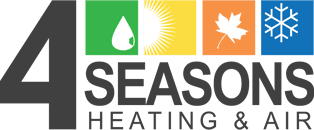Since winter weather is on its way to Alpharetta, GA, it’s time to start thinking about your furnace. Because furnaces burn natural gas and involve both flames and electricity, it’s important to know how to use them safely. You also need to know what to do if you suspect there’s a problem with your furnace. At [company_name], our skilled technicians offer these 10 furnace safety tips to keep your household safe and comfortable this winter.
1. Keep Combustible Items Away
No combustible or flammable materials should be in the same room or area as your furnace. Combustible materials include motor oil, gasoline, lighter fluid, paint thinner and matches. Flammable materials include cardboard, paper, clothing, upholstered furniture, rugs and more. If your furnace were to catch on fire, the flames could easily spread to flammable or combustible materials, causing the fire to rapidly spread throughout your home.
2. Clean Vents and Ducts
Dust buildup in your home’s air vents impedes airflow. If the warmed air can’t get into your living spaces, this causes a lot of unnecessary wear and tear on your furnace. A backup of air could also cause a furnace fire. Once every week, use your vacuum to clean the dust off the air vents and out of the duct openings. You may need to use a screwdriver to remove the vent covers. Every one to three years, have your home’s air ducts professionally cleaned. Getting rid of the dust and debris in the ducts could improve airflow and the consistency of your home’s temperatures. Your furnace may also work more efficiently when the ducts and vents are clean.
3. Check Flue Openings
Check your flue openings for obstructions. Birds’ nests, rodent nests and leaves may be stuck in the flue. When your furnace burns natural gas, it creates combustion byproducts. These are gases that are blown out of your home through the flue. It’s important for these waste gases to exit your home. The toxic gases include carbon monoxide, methane, sulfur dioxide and nitrogen oxides. These gases cause immediate and long-term health effects. For example, low levels of exposure to carbon monoxide mimic the symptoms of influenza. At moderate levels of carbon monoxide exposure, you may feel confused and disoriented. At high levels, you can lose consciousness or lose your life.
4. Test Carbon Monoxide and Smoke Detectors
A problem with your furnace or flue could result in carbon monoxide gas leaking into your home. Carbon monoxide replaces oxygen in your blood. This starves your brain of oxygen and can lead to death. Once each month, check your carbon monoxide detector. It’s also wise to check your smoke alarm at the same time. If your alarms are hardwired, be sure to check their batteries. They need a backup battery in case of a power outage. Smoke alarms have a lifespan of about 10 years. If yours is older than this, now is a good time to replace it.
5. Replace the Air Filter
Your furnace has a filter. Its job is to capture tiny particles from the air. Those particles could make the furnace’s parts dirty. Dirt buildup on a sensor, the igniter or heat exchanger could cause a system breakdown or failure. Once each month, check your furnace filter. To do this, wait until a heating cycle ends. You can then turn off the power to your furnace. After accessing the filter’s housing, slide the filter out. If the filter is visibly dirty, remove and replace it. Replace your furnace filter at least every three months. When inserting the new filter, make sure it’s in the correct orientation. It should have arrows that align with the arrows marked on the housing. The old, dirty filter should be thrown away.
6. Maintain Airflow
Furnaces require plenty of fresh air to burn natural gas. Without enough airflow, the furnace won’t efficiently burn fuel. Insufficient airflow may cause the pilot light to go out. The fuel could also incompletely burn, resulting in more ash or toxic gas buildup. Maintain at least 6 feet of clearance in all directions around your furnace. Avoid storing bins or boxes of items that impede airflow. If there’s an air intake vent going through an exterior wall of your home, keep vegetation trimmed away from it. You may need to trim the vegetation once per month, especially for fast-growing shrubs, grass or tree branches. On the other hand, too much airflow can also be a problem. Don’t put any fans near your furnace. This includes portable humidifiers and dehumidifiers, which use a fan to move air.
7. Remove Clutter
Keep clutter away from your home’s vents, air ducts and furnace. Piles of items reduce airflow. The items can also get hot, which puts them at risk of igniting. Clutter also interferes with heat distribution. If intake or supply vents are blocked by piles of items, some areas of your home may feel too cold. Clutter also makes it more difficult to detect a problem with your furnace, and the repair technician may not be able to access the furnace in order to inspect it for problems.
8. Establish a No-Play Zone
If your furnace is in the basement or a utility area that children or pets can access, teach them to stay away from it. The furnace can be hot to the touch. It has wires and pipes leading to it, and rough play could damage them. It’s best to keep children and pets out of the area where the furnace is located. Avoid putting toys or other items that a child or pet would want near a furnace.
9. Look and Sniff Regularly
Once every couple of days, take a look around your furnace. If you notice something new, such as ash, a greasy film or pest nesting materials, it’s a good idea to call for an inspection. Take a few deep breaths. If you detect a foul odor like rotten eggs, your furnace could have a gas leak. This odor is from the mercaptan chemical added to natural gas to make it detectable by the human nose. Also beware of a chemical or burning smell. These odors could result from debris in the combustion chamber or a crack in the heat exchanger. If you smell an odor coming from your furnace, get everyone out of your home. Immediately call for repairs.
10. Schedule an Annual Tune-up
An annual tune-up includes a complete system safety and performance test for your furnace. The technicians at [company_name] can check for a range of possible issues, such as cracks in the heat exchanger or dirty sensors. Your annual furnace tune-up will also involve cleaning the combustion chamber, inspecting the safety valves and measuring the rate of gas flow and waste removal.
[company_name] is Alpharetta’s trusted provider of furnace repairs. We’re also ready to provide you with dependable heating and air conditioning maintenance, replacement, installation and repair services. For additional furnace safety tips, give us a call.








